Your cosmetic dental practice is bleeding patients.
Not because your veneers aren’t flawless. Not because your front desk isn’t friendly. And definitely not because you’re underqualified.
You’re losing patients because they can’t find you.
And if they can’t find you, they can’t book you. It’s that simple.
In 2025, 93% of dental patients search online before calling a practice. If your name doesn’t show up, your competitors are more than happy to scoop up the traffic—and the revenue.
Most cosmetic dentists throw cash at paid ads or fancy redesigns that don’t actually convert. Meanwhile, they ignore the one thing that brings in patients consistently, month after month: SEO.
I’ve audited over 50 cosmetic dental sites this year alone, and the pattern is always the same:
- The design looks nice.
- The service list is long.
- And the SEO is a dumpster fire.
But here’s the truth—SEO for cosmetic dental practices isn’t rocket science. It’s about knowing what real patients search for and making damn sure your site shows up when they do.
I’m giving it to you straight. You’ll learn:
- Why your current site isn’t ranking (even if it looks great)
- The SEO strategies that actually bring in new patients
- How to turn your site into a booking machine
- Why 90% of your competitors will never do this (and how you can win because of it)
If you’re serious about growing your practice, dominating your local search results, and being booked solid without wasting money on ads, you’re in the right place.
Let’s get into it.
Key Takeaways:
Show Up or Lose: If patients can’t find you in search, they’ll book elsewhere—paid ads and design won’t save you.
Solid Site = SEO Basics: A fast, mobile-friendly site with proper title tags, meta descriptions, and headers is mandatory or Google will ignore you.
Local SEO Is Nonnegotiable: Claim and optimize your Google Business Profile, use geo-keywords and city-specific pages, and keep NAP consistent to land in the Local 3-Pack.
Traffic ≠ Patients—Convert: Prominent “Book Now” buttons, genuine testimonials, before/after photos, and retargeting ads turn clicks into appointments.
SEO Is Ongoing: Perform monthly audits, track performance, publish fresh expert content, and add structured data, video, and FAQ schema to stay ahead.
The Real Reason Cosmetic Dentists Aren’t Showing Up on Google
Let’s cut to the chase: You didn’t spend years perfecting smile makeovers just to sit on page 5 of Google.
But that’s exactly where most cosmetic dental practices are hiding—buried under competitors who figured out how SEO works while you were busy drilling and billing. And if your site’s invisible, you’re leaving serious money on the table.
According to a recent study by Backlinko, the #1 organic search result in Google gets 27.6% of all clicks. The second result? 15%. By the time you hit the bottom of page one, you’re lucky to snag 2%.
So yeah—if you’re not in the top three, you’re basically invisible.
Here’s what most dentists don’t realize: Patients aren’t searching for “comprehensive cosmetic solutions.”
They’re typing in:
- “Best teeth whitening near me”
- “Affordable veneers in Austin”
- “Fix chipped tooth fast Los Angeles”
If your site isn’t built around those real-world searches, Google skips right past you—and sends patients to someone who speaks their language.
The Worst Part? Your Competitors Aren’t Even That Good.
Here’s the kicker: half the practices ranking ahead of you aren’t even better than you. Their work might be mediocre, their reviews average, their tech outdated.
But they show up first, so they win the click—and usually, the patient.
That’s the harsh truth of digital marketing in 2025. It’s not the “best dentist” who wins—it’s the one who knows how to show up first.
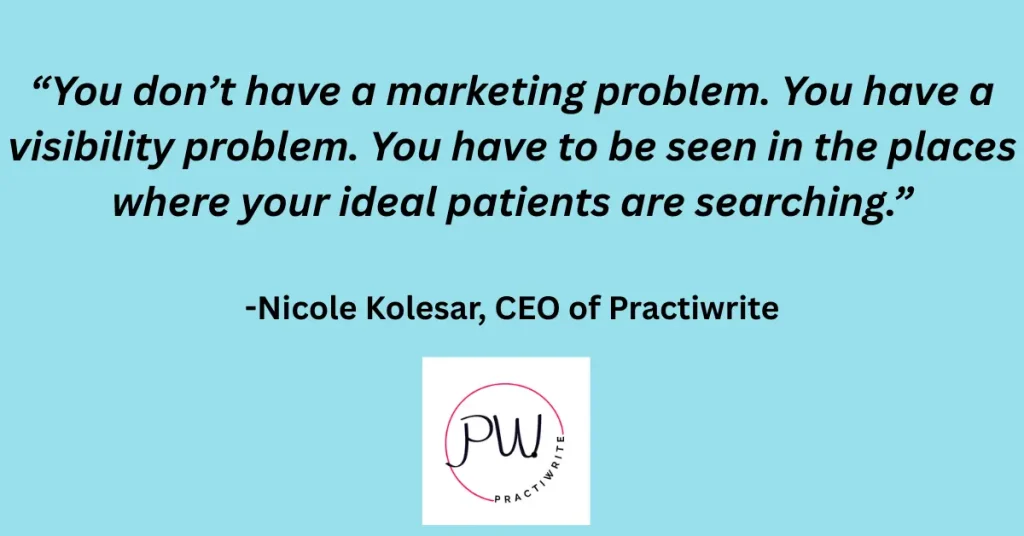
SEO isn’t about gaming the algorithm. It’s about:
- Understanding what real people are typing into that search bar
- Structuring your site so Google loves to show it off
- Giving patients a reason to click you, not the guy down the street
And the best part? Most of your competitors will never do this work. That’s your opening.
Let’s break down exactly how to take it.
Foundation First: How to Fix What’s Broken on Your Website
Before we talk strategy, ads, or anything remotely fancy—we fix the foundation. Because if your website is slow, hard to navigate, or invisible to Google, nothing else matters.
Think of your site like your dental office. Would you start marketing a smile makeover before the equipment’s installed and the chairs are bolted down?
Didn’t think so.
Same logic applies here.
A sleek homepage and pretty logo don’t mean jack if your backend SEO is a mess. Let’s get under the hood and fix what’s keeping Google (and patients) from giving your site the time of day.
Check How Google Sees You (Because It Might Be Brutal)
Google is your new gatekeeper. And if it doesn’t understand your site, it won’t show it.
Start by running your site through:
- Google Analytics – to see how people interact with your content
- Google Search Console – to identify crawl issues, ranking problems, and indexing errors
- Google PageSpeed Insights – because a slow site = dropped rankings
Here’s why this matters:
- 40% of users will abandon a site that takes longer than 3 seconds to load (source)
- Mobile-first indexing is real—over 63% of all Google searches come from mobile devices (Statista, 2024)
So if your site loads like it’s stuck in 2007, you’re losing traffic and patients before they even see what you offer.
Nail Your On-Page SEO Like a Pro (or Get Left Behind)
This is the part most agencies overcomplicate with jargon. Here’s what you actually need to care about:
What Google Looks At First:
- Title Tags – The clickable headline in search results. Must include a primary keyword (e.g., “Cosmetic Dentist in Denver – Smile Reimagined”).
- Meta Descriptions – This is your digital elevator pitch. Use it to hook readers with a benefit (“Get brighter, straighter teeth in just one visit.”)
- Headers (H1, H2, etc.) – These organize your content and help Google scan it fast. Think of them like topic signs in a dental brochure.
If your pages don’t include real phrases patients are searching, Google won’t rank them. And if your title tags say things like “Home | SmileWorks,” you’re throwing away free traffic.
Pro tip: Don’t guess—use tools like Ubersuggest or Semrush to find what people in your area are typing in.
Use Keywords Patients Actually Use (Not Dental Jargon)
Dental jargon = no conversions. Here’s the disconnect: Dentists say “enamel microabrasion.” Patients Google “get rid of white spots on teeth.”
See the problem?
You need to meet patients where they are—with plain, human words. Use long-tail, location-based keywords like:
- “veneers in Miami”
- “natural-looking crowns Boston”
- “best cosmetic dentist for gaps Los Angeles”
92.42% of keywords get ten searches a month or fewer (Ahrefs, 2024)—which means low-competition, high-intent searches are your goldmine.
Improve User Experience or Google Will Ignore You
Google is watching how users interact with your site. If they bounce quickly or can’t figure out how to book, it dings your rankings.
Here’s what matters most:
- Mobile design – Use Google’s Mobile-Friendly Test to see if your site passes.
- Fast load times – Compress images. Kill bloated plugins. Move to faster hosting if needed.
- Clear booking options – Don’t bury your contact info behind five clicks. Make it insanely easy to schedule.
Your site should feel like your front desk—friendly, fast, and frictionless.
Quick Fix Checklist (Save or Screenshot This)
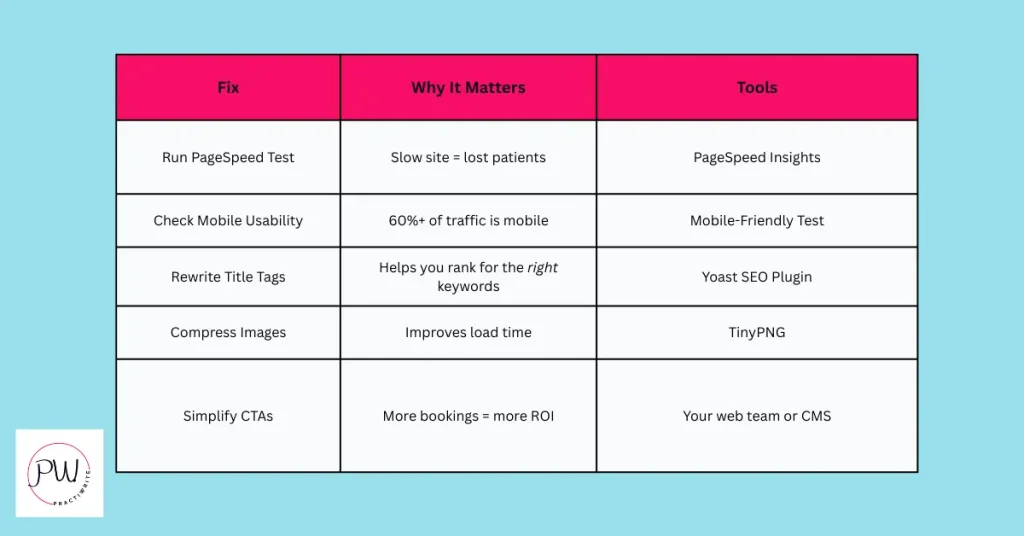
By fixing your foundation now, you unlock everything else we’ll cover in this guide—local SEO, conversion optimization, ranking strategy, and patient acquisition.
Don’t skip this part. It’s not sexy, but it’s the difference between “meh” traffic and fully booked weeks.
Local SEO That Drives Cosmetic Patients in Your Area
Here’s the truth most SEO “experts” won’t tell you: If you don’t show up locally, you don’t show up at all.
You’re a cosmetic dentist. That means your patients are local. They’re not flying in from three states away—they’re looking for a trusted provider down the street.
Which is why local SEO isn’t optional. It’s the backbone of your entire patient acquisition strategy.
Let’s get you showing up first when someone Googles “veneers near me” instead of being buried under Groupon deals and chain clinics.
Claim and Optimize Your Google Business Profile (or Stay Invisible)
First thing’s first: your Google Business Profile is more important than your website. Yep, I said it.
It’s the box that shows up on the side of the screen when someone Googles you. It shows your hours, reviews, location, photos—and whether you’re worth calling.
And most practices barely touch it.
Here’s how to fix that:
- Go to Google Business Profile and claim your listing.
- Add every detail possible: business hours, services, appointment links, photos of your office and team.
- Choose the right categories: “Cosmetic Dentist,” “Teeth Whitening Service,” etc.
- Turn on messaging so potential patients can text you directly.
- Ask for reviews consistently. Not once. Not when you remember. Make it a system.
81% of patients read reviews before choosing a healthcare provider. So if you don’t have recent, positive reviews, you’re toast.
Add Local Keywords That Actually Attract Nearby Patients
Generic keywords won’t cut it anymore. You need geo-targeted terms that match how people search.
Think:
- “Teeth bonding in Dallas”
- “Porcelain veneers Scottsdale”
- “Cosmetic dental office near me open Saturday Boston”
Here’s how to find them:
- Use Google Keyword Planner to research localized dental terms
- Check the “People Also Ask” section on Google for your service + city
- Spy on competitors using Ahrefs or Semrush
Then, work those keywords into:
- Your homepage and service pages
- Your page titles and meta descriptions
- Blog content and FAQs
Create City Pages if You Serve Multiple Locations
If you serve more than one city, don’t try to rank for all of them on one generic page. Google hates that. Patients do too.
Instead, create dedicated location pages for each major city or area:
- /veneers-boca-raton
- /cosmetic-dentistry-charlotte
- /smile-makeovers-orange-county
These pages should each include:
- Services you offer in that city
- A map of your location or service area
- Local testimonials, if available
- Geo keywords in headers and content
Bonus tip: Use local slang or nicknames if your area has them. It builds trust with patients—and Google.
Get Listed in Local Directories (and Make Sure They Match)
Google checks to see if your business info (Name, Address, Phone number—aka NAP) is consistent across the web. If it’s not? Your rankings drop.
You need to be listed in:
- Healthgrades
- Yelp
- Zocdoc
- Vitals
- Local Chamber of Commerce directories
Use a tool like BrightLocal to find missing or inconsistent citations. Then, make sure every listing matches your Google Business Profile exactly.
Quick Wins: Local SEO Checklist for Cosmetic Dentists
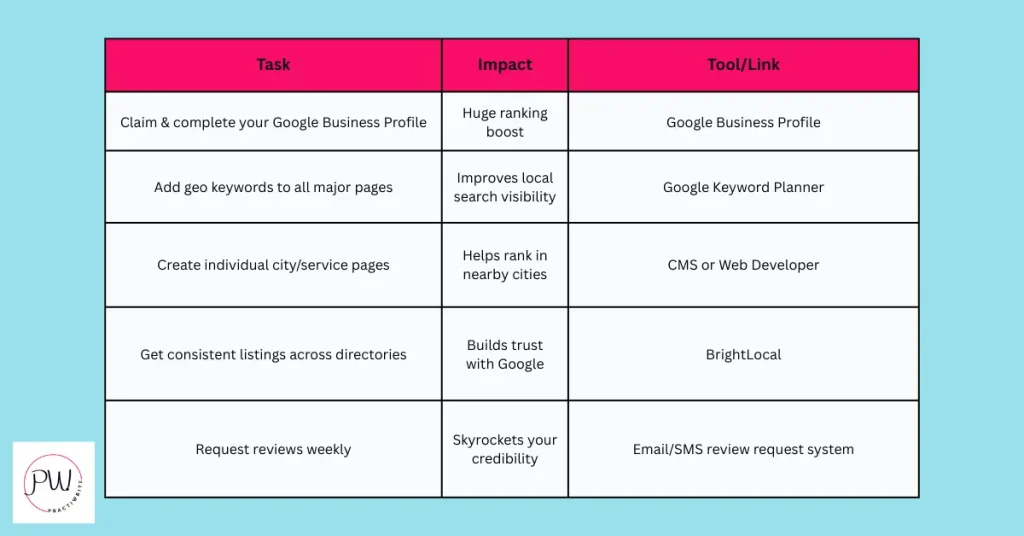
If your local SEO isn’t locked in, you’re not just missing traffic—you’re giving it away. To the dentist down the street. The one with worse results, worse reviews, and worse customer service.
Fix this now, and you’ll start seeing results faster than almost any other SEO move you can make.
Turn Traffic Into Bookings: Patient-Centered Website Strategies
So, your site finally ranks. People are clicking. That’s great.
But clicks don’t pay the bills. Appointments do.
If your site isn’t built to convert, all that hard-earned SEO traffic goes to waste. Think of it like having a gorgeous office… with a locked front door.
Here’s how to make sure your site doesn’t just attract patients—it books them.
Make It Stupid-Easy to Book an Appointment
I’m going to say this loud for the people in the back:
If someone has to hunt to find your phone number or booking link, you’ve already lost them.
Here’s what a conversion-focused site looks like:
- A giant “Book Now” button at the top of every page
- Easy-to-fill forms with minimal fields (Name, contact info, preferred time—done.)
- Multiple booking options: online form, call, text
- A direct CTA like “Schedule your appointment” that links to your booking page:
👉 https://yoursite.com/contact
💡 Pro tip: Use contrasting colors for your buttons—blue or green work best for healthcare. And don’t be afraid to repeat the CTA multiple times on each page.
People don’t scroll to the bottom. Give them that “Book Now” option early and often.
Use Testimonials & Before/After Photos as Proof You’re Legit
People don’t just want a dentist. They want proof they’re making the right call.
That’s where social proof comes in. Showcase:
- Patient testimonials with real names and photos (get permission!)
- Video testimonials if possible (these are gold for trust)
- Before-and-after smile transformations—label each with the procedure performed
Not only do testimonials improve trust—they increase conversion rates. According to Spiegel Research Center, products with reviews have a 270% higher chance of converting. And yes, your dental services count as a product.
Tell People What to Do. Then Tell Them Again.
Most websites assume visitors will magically know what to do. Nope. You’ve got to spell it out.
Every page should have a clear, direct CTA:
- “Book your free strategy session today”
- “Schedule your cosmetic consult”
- “Find out how your site can bring in more patients (without ads)”
And every CTA should link to one place: https://yoursite.com/contact
This is the action we want. Make it obvious. Make it easy.
Set Up Retargeting (Because Not Everyone Books the First Time)
Most people won’t convert on their first visit. Life gets in the way, distractions happen, dogs bark, kids cry.
That’s where retargeting comes in. Set up retargeting pixels from:
- Meta (Facebook + Instagram)
- Google Ads
So when someone lands on your services page but doesn’t book, they’ll start seeing:
- “Still thinking about veneers?” ads
- “Want to boost your smile confidence?” messages
- Reminders that your free strategy session is still waiting
These ads work. Why? Because the viewer already knows who you are.
Bonus: Include urgency. “Summer is right around the corner so spots are filling up fast—secure your spot.”
Quick Conversion Optimization Checklist for Your Website
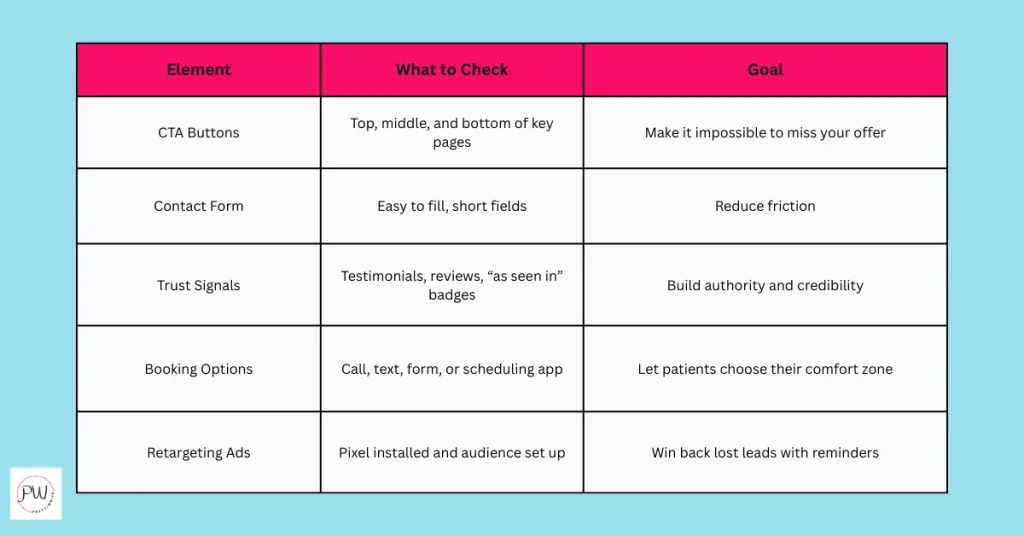
Your website shouldn’t just look good—it should work hard.
Make it a 24/7 booking machine that’s focused on one job: getting real patients in the chair.
SEO Is Not One-and-Done: What Top Practices Do Monthly
Look—if you think SEO is something you “set and forget,” I’ve got bad news: That mindset is exactly why your competitor is outranking you right now.
The top cosmetic dental practices don’t treat SEO like a checkbox. They treat it like their growth engine.
Because it is.
The practices I work with don’t just “rank”—they own the top spots, month after month. Here’s how they do it.
Run Monthly SEO Audits and Keep Your Site Clean
SEO is like oral hygiene. Skip it too long, and decay sets in.
You should be checking for:
- Broken links
- Outdated or duplicate content
- Missing metadata
- Page speed issues
- Technical errors that block search engines
Tools that do this beautifully:
- Screaming Frog – scans your entire site for SEO issues
- Ahrefs Site Audit – shows what’s broken and how to fix it
- Google Search Console – for indexing and page experience insights
Pro tip: Set a calendar reminder to audit once a month. Don’t wait until traffic crashes.
Use Your Analytics to Double Down on What’s Working
Data doesn’t lie. And if you’re not using your numbers to guide your strategy, you’re flying blind.
Pull these reports monthly:
- Top landing pages – What’s bringing in the most traffic?
- High bounce pages – Where are people dropping off?
- Search terms – What keywords are converting into actual bookings?
Use Google Analytics 4 and Search Console to get these insights.
Then tweak:
- Double down on pages that convert—optimize them even further
- Rewrite or improve pages with high bounce rates
- Add more content around your highest-converting keywords
Reminder: You’re not trying to “rank for everything.” You’re trying to convert the right traffic into real patients.
Add Fresh Content (Google Eats This Stuff Up)
If your site hasn’t been updated in months, Google assumes it’s stale. And stale sites don’t rank.
Blogging monthly is one of the easiest ways to:
- Add new keywords
- Show Google your site is active
- Educate and convert patients
Here’s what to blog about:
- “Best teeth whitening options in [City]”
- “What to know before getting veneers”
- “Cost of cosmetic dentistry explained (no fluff)”
Need a content engine? That’s where Practiwrite comes in. But even if you DIY it—do it consistently.
Websites that blog consistently get 67% more leads per month than those that don’t.
Bonus: Make your content work as hard as you do. Include a content distribution and repurposing plan with EVERY blog you create.
Sneak Peek: Make Your Life Easier with a Plug-and-Play Checklist
Having a quick Cosmetic Dentistry SEO Checklist—a companion to this post that lays out exactly what to do, step-by-step, every month.
And yes—it’s free. You can grab it right here.
Quick Monthly SEO Workflow (Save This!)
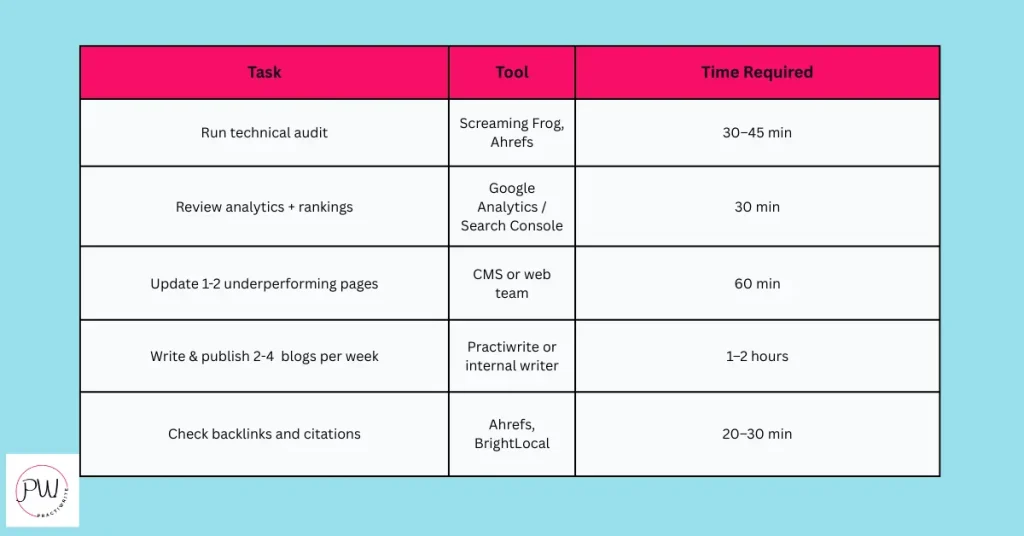
That’s about 4–5 hours per month to keep your SEO sharp and your site converting.
Or you can ignore it, watch traffic tank, and wonder why the dentist with worse reviews is stealing your patients. Your call.
Advanced Cosmetic Dental SEO: Stand Out in a Crowded Market
Most cosmetic dentists stop at “basic SEO.” They optimize a few pages, post a blog once in a blue moon, maybe fiddle with their Google profile—and then wonder why they’re still stuck under the same five local listings.
Here’s the truth: if you want next-level visibility, you need next-level strategy.
This section is where we separate the thriving practices from the invisible ones.
Add Structured Data (So Google Actually Understands Your Site)
Ever wonder how some dentists get star ratings, service lists, or FAQ dropdowns right in their Google results?
That’s structured data at work.
By adding a bit of code called JSON-LD to your site, you’re helping Google understand:
- What services you offer
- What your reviews say
- Where you’re located
- What your business hours are
It’s how you earn rich snippets, which get 58% of all search clicks.
Here’s what to do:
- Visit Schema.org to find examples for local business and medical practice markup
- Use Google’s Structured Data Markup Helper if you’re DIY-ing it
- Or have your developer add structured data for:
- Services (veneers, whitening, smile makeovers)
- Reviews
- FAQs
- Business info (NAP)
- Services (veneers, whitening, smile makeovers)
Important: Always test your markup using Google’s Rich Results Test Tool to catch errors before publishing.
Create Geo-Targeted Service Pages to Rank in Multiple Cities
Let’s say you’re based in Phoenix—but your patients come from Scottsdale, Mesa, and Tempe too.
If you’re not creating individual pages for those areas, you’re leaving a pile of search traffic on the table.
How it works:
Create a unique, optimized page for each nearby city you serve.
Example:
- /cosmetic-dentist-scottsdale
- /veneers-mesa
- /teeth-whitening-tempe
Each page should include:
- Local headlines (e.g., “Smile Makeovers for Scottsdale Professionals”)
- Geo-specific keywords
- Google Maps embed or service area map
- Local testimonials if available
These pages don’t just improve rankings—they also make you look hyper-relevant to each community you serve.
Pro tip: Avoid “copy/paste” pages with just city names swapped. Google hates that. Make each one unique and useful.
Use Video to Build Trust and Boost SEO (Google Loves It)
Video isn’t just for social. It keeps people on your site longer, boosts trust, and improves conversions.
In fact, pages with video are 53x more likely to rank on the first page of Google. Here’s how to make it work for your practice:
- Create a virtual office tour. Show your tech, your treatment rooms, and your vibe.
- Record short procedure explainers. “What to expect with veneers” or “Teeth whitening FAQs”
- Capture patient testimonials on camera. Bonus points if you do before-and-after reveals.
- Post to YouTube and embed on your site. This gives you searchability on two major platforms.
Keep it casual and friendly. You don’t need studio-quality lighting—just honesty, personality, and clarity.
Bonus: Launch a Branded FAQ Section (with SEO Power)
Patients Google weirdly specific stuff. If your site answers those questions better than anyone else, you win.
Create a standalone FAQ page or add questions to your service pages like:
- “How long do veneers last?”
- “Does teeth whitening hurt?”
- “Is cosmetic dentistry covered by insurance?”
Use schema markup on your FAQ content, and you could show up in “People Also Ask” or with collapsible questions right in search.
These FAQ sections don’t just help your SEO—they reduce calls to your front desk asking the same questions over and over.
Quick Advanced SEO Moves for Practice Owners
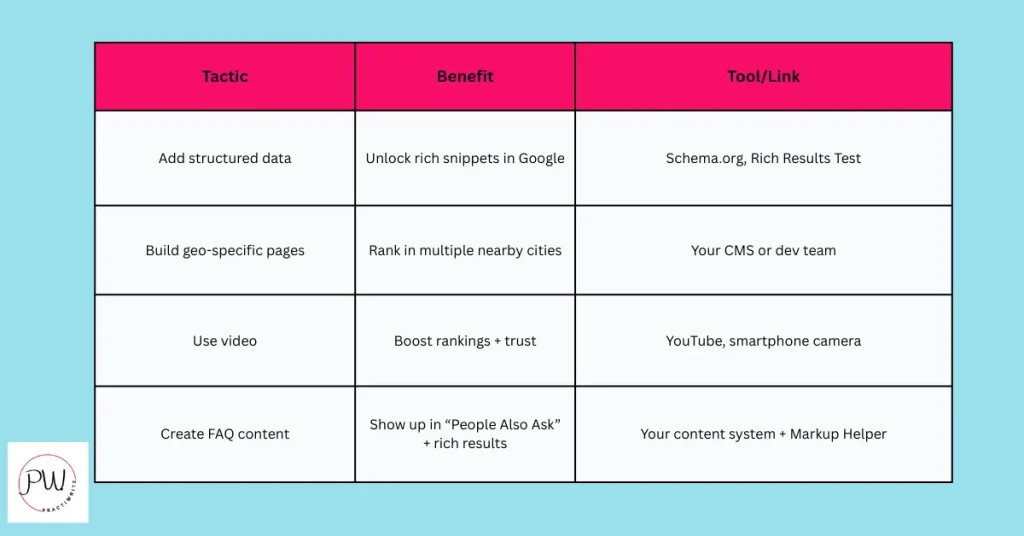
You don’t have to do all of this overnight. But if you want to own your market—not just survive in it—you need to be playing where your competitors aren’t.
The Bottom Line: SEO Is Your Patient Pipeline—Treat It Like One
Let’s not sugarcoat it: If you’re not investing in your SEO, you’re handing your future patients to the dentist down the street. The one with worse reviews, fewer certifications, and maybe even lower prices.
They’re not winning because they’re better.
They’re winning because they show up when your potential patients search.
And that’s what this whole guide has been about: Getting your name to the top of Google.
Turning your website into a lead machine.
And making damn sure your schedule stays booked with high-value cosmetic cases.
Here’s the reality you need to face: SEO works—but it’s work.
It’s technical. It’s time-consuming. And it’s not what you went to dental school to do.
You’re in the business of transforming smiles. We’re in the business of making sure the right people find you before they find someone else.
That’s why I created the Dental Practice SEO Sprints—done-for-you, no-fluff system designed specifically for cosmetic dental practices that are serious about growth.
And right now, you can book a free, no-BS strategy session to get your customized Dental Practice Roadmap.
This is where we:
- Audit what’s working (and what’s not) on your site
- Identify the keywords you should be ranking for—but aren’t
- Lay out the exact SEO strategy to help you dominate your market
And yeah, it’s actually free.
Because I only work with two practices per state. So if we’re a fit, we go hard.
If not? You still leave with a clear roadmap you can act on.
Stop guessing. Stop wasting money on ads that don’t convert.
Start getting booked out with high-quality cosmetic cases—consistently.
Your future patients are already searching.
Let’s make sure they find you first.
10+ year content strategist, writer, author, and SEO consultant. I work exclusively with dental practices that want to grow and dominate their local areas.
